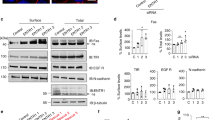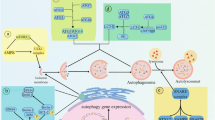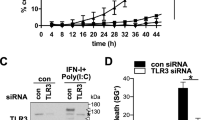Abstract
Here we describe a mechanism that cancer cells use to survive when flux through the Src/FAK pathway is severely perturbed. Depletion of FAK, detachment of FAK-proficient cells or expression of non-phosphorylatable FAK proteins causes sequestration of active Src away from focal adhesions into intracellular puncta that co-stain with several autophagy regulators. Inhibition of autophagy results in restoration of active Src at peripheral adhesions, and this leads to cancer cell death. Autophagic targeting of active Src is associated with a Src–LC3B complex, and is mediated by c-Cbl. However, this is independent of c-Cbl E3 ligase activity, but is mediated by an LC3-interacting region. Thus, c-Cbl-mediated autophagic targeting of active Src can occur in cancer cells to maintain viability when flux through the integrin/Src/FAK pathway is disrupted. This exposes a previously unrecognized cancer cell vulnerability that may provide a new therapeutic opportunity.
This is a preview of subscription content, access via your institution
Access options
Subscribe to this journal
Receive 12 print issues and online access
$209.00 per year
only $17.42 per issue
Buy this article
- Purchase on Springer Link
- Instant access to full article PDF
Prices may be subject to local taxes which are calculated during checkout








Similar content being viewed by others
References
Thomas, S. M. & Brugge, J. S. Cellular functions regulated by Src family kinases. Annu. Rev. Cell Dev. Biol. 13, 513–609 (1997).
Sandilands, E. et al. RhoB and actin polymerization coordinate Srcactivation with endosome-mediated delivery to the membrane. Dev. Cell 7, 855–869 (2004).
Cartwright, C. A., Kamps, M. P., Meisler, A. I., Pipas, J. M. & Eckhart, W. pp60c-src activation in human colon carcinoma. J. Clin. Invest. 83, 2025–2033 (1989).
Verbeek, B. S. et al. c-Src protein expression is increased in human breast cancer. An immunohistochemical and biochemical analysis. J. Pathol. 180, 383–388 (1996).
Irby, R. B. et al. Activating SRC mutation in a subset of advanced human colon cancers. Nat. Genet 21, 187–190 (1999).
Cartwright, C. A., Meisler, A. I. & Eckhart, W. Activation of the pp60c-src protein kinase is an early event in colonic carcinogenesis. Proc. Natl Acad. Sci. USA 87, 558–562 (1990).
McLean, G. W. et al. Specific deletion of focal adhesion kinase suppressestumor formation and blocks malignant progression. Genes Dev. 18, 2998–3003 (2004).
Morton, J. P. et al. Dasatinib inhibits the development of metastases in a mouse model of pancreatic ductal adenocarcinoma. Gastroenterology 139, 292–303 (2010).
Pankiv, S. et al. p62/SQSTM1 binds directly to Atg8/LC3 to facilitate degradation of ubiquitinated protein aggregates by autophagy. J. Biol. Chem. 282, 24131–24145 (2007).
Kirkin, V. et al. A role for NBR1 in autophagosomal degradation of ubiquitinated substrates. Mol. Cell 33, 505–516 (2009).
Klionsky, D. J. et al. Guidelines for the use and interpretation of assays for monitoring autophagy in higher eukaryotes. Autophagy 4, 151–175 (2008).
Kimura, S., Noda, T. & Yoshimori, T. Dissection of the autophagosome maturation process by a novel reporter protein, tandem fluorescent-tagged LC3. Autophagy 3, 452–460 (2007).
Kimura, S., Fujita, N., Noda, T. & Yoshimori, T. Monitoring autophagy in mammalian cultured cells through the dynamics of LC3. Methods Enzymol. 452, 1–12 (2009).
Hara, T. et al. FIP200, a ULK-interacting protein, is required for autophagosome formation in mammalian cells. J. Cell Biol. 181, 497–510 (2008).
Timpson, P., Jones, G. E., Frame, M. C. & Brunton, V. G. Coordination of cell polarization and migration by the Rho family GTPases requires Src tyrosine kinase activity. Curr. Biol. 11, 1836–1846 (2001).
Westhoff, M. A., Serrels, B., Fincham, V. J., Frame, M. C. & Carragher, N. O. SRC-mediated phosphorylation of focal adhesion kinase couples actin and adhesion dynamics to survival signaling. Mol. Cell Biol. 24, 8113–8133 (2004).
Yokouchi, M. et al. Src-catalyzed phosphorylation of c-Cbl leads to the interdependent ubiquitination of both proteins. J. Biol. Chem. 276, 35185–35193 (2001).
Andoniou, C. E., Thien, C. B. & Langdon, W. Y. Tumour induction by activated abl involves tyrosine phosphorylation of the product of the cbl oncogene. EMBO J. 13, 4515–4523 (1994).
Joazeiro, C. A. et al. The tyrosine kinase negative regulator c-Cbl as a RING-type, E2-dependent ubiquitin-protein ligase. Science 286, 309–312 (1999).
Levkowitz, G. et al. Ubiquitin ligase activity and tyrosine phosphorylation underlie suppression of growth factor signaling by c-Cbl/Sli-1. Mol. Cell 4, 1029–1040 (1999).
Bjorkoy, G. et al. Monitoring autophagic degradation of p62/SQSTM1. Methods Enzymol. 452, 181–197 (2009).
Mathew, R. et al. Autophagy suppresses tumorigenesis through elimination of p62. Cell 137, 1062–1075 (2009).
Acknowledgements
This work was supported by Cancer Research UK (Program Grant to M.C.F. number: C157/A11473), a CR-UK Career Development Fellowship to S.W. and Beatson Institute core grants to O.J.S. and M.V. We thank P. Timpson (Beatson Institute, UK) for reagents.
Author information
Authors and Affiliations
Contributions
E.S. and B.S. contributed equally to experimental work, project planning and data analysis. D.G.M., K.M., J. P. Morton and J. P. Macagno contributed to the experiments described in this manuscript. C.S., V.G.B., M.V., O.J.S. and I.D. provided intellectual input. W.Y.L. provided c-Cbl reagents. S.W. carried out electron microscopy and contributed to project planning and interpretation of data. M.C.F. was the grant holder and principal investigator under whom this work was carried out.
Corresponding authors
Ethics declarations
Competing interests
The authors declare no competing financial interests.
Supplementary information
Supplementary Information
Supplementary Information (PDF 2417 kb)
Rights and permissions
About this article
Cite this article
Sandilands, E., Serrels, B., McEwan, D. et al. Autophagic targeting of Src promotes cancer cell survival following reduced FAK signalling. Nat Cell Biol 14, 51–60 (2012). https://doi.org/10.1038/ncb2386
Received:
Accepted:
Published:
Issue Date:
DOI: https://doi.org/10.1038/ncb2386
This article is cited by
-
SEMA6C: a novel adhesion-independent FAK and YAP activator, required for cancer cell viability and growth
Cellular and Molecular Life Sciences (2023)
-
Autophagy, molecular chaperones, and unfolded protein response as promoters of tumor recurrence
Cancer and Metastasis Reviews (2023)
-
Endosomal LC3C-pathway selectively targets plasma membrane cargo for autophagic degradation
Nature Communications (2022)
-
Comprehensive understanding of anchorage-independent survival and its implication in cancer metastasis
Cell Death & Disease (2021)
-
Rab26 suppresses migration and invasion of breast cancer cells through mediating autophagic degradation of phosphorylated Src
Cell Death & Disease (2021)



